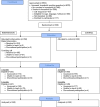Minimal intervention delivered by 2-1-1 information and referral specialists promotes smoke-free homes among 2-1-1 callers: a Texas generalisation trial
- PMID: 27697943
- PMCID: PMC5099226
- DOI: 10.1136/tobaccocontrol-2016-053045
Minimal intervention delivered by 2-1-1 information and referral specialists promotes smoke-free homes among 2-1-1 callers: a Texas generalisation trial
Abstract
Background: Replication of intervention research is reported infrequently, limiting what we know about external validity and generalisability. The Smoke Free Homes Program, a minimal intervention, increased home smoking bans by United Way 2-1-1 callers in randomised controlled trials in Atlanta, Georgia and North Carolina.
Objective: Test the programme's generalisability-external validity in a different context.
Methods: A randomised controlled trial (n=508) of English-speaking callers from smoking-discordant households (≥1 smoker and ≥1 non-smoker). 2-1-1 Texas/United Way HELPLINE call specialists serving the Texas Gulf Coast recruited callers and delivered three mailings and one coaching call, supported by an online tracking system. Data collectors, blind to study assignment, conducted telephone interviews 3 and 6 months postbaseline.
Results: At 3 months, more intervention households reported a smoke-free home (46.6% vs 25.4%, p<0.0001; growth model intent-to-treat OR=1.48, 95% CI 1.241 to 1.772, p<0.0001). At 6 months, self-reported full bans were 62.9% for intervention participants and 38.4% for controls (OR=2.19). Texas trial participants were predominantly women (83%), single-smoker households (76%) and African-American (65%); half had incomes ≤US$10 000/year (50%). Texas recruitment was <50% of the other sites. Fewer callers reported having a smoker in the household. Almost twice the callers with a household smoker declined interest in the programme/study.
Conclusions: Our findings in a region with lower smoking rates and more diverse callers, including English-speaking Latinos, support programme generalisability and convey evidence of external validity. Our recruitment experience indicates that site-specific adjustments might improve recruitment efficiency and reach.
Trial registration number: NCT02097914, Results.
Keywords: Environment; Prevention; Secondhand smoke; Socioeconomic status.
Published by the BMJ Publishing Group Limited. For permission to use (where not already granted under a licence) please go to http://www.bmj.com/company/products-services/rights-and-licensing/.
Figures
References
-
- Centers for Disease Control and Prevention (CDC). Vital signs: nonsmokers’ exposure to secondhand smoke—United States, 1999–2008. MMWR Morb Mortal Wkly Rep 2010;59:1141–6. - PubMed
-
- Mills AL, White MM, Pierce JP, et al. . Home smoking bans among US households with children and smokers. Opportunities for intervention. Am J Prev Med 2011;41:559–65. - PubMed
Publication types
MeSH terms
Substances
Associated data
Grants and funding
LinkOut - more resources
Full Text Sources
Other Literature Sources
Medical
Miscellaneous

